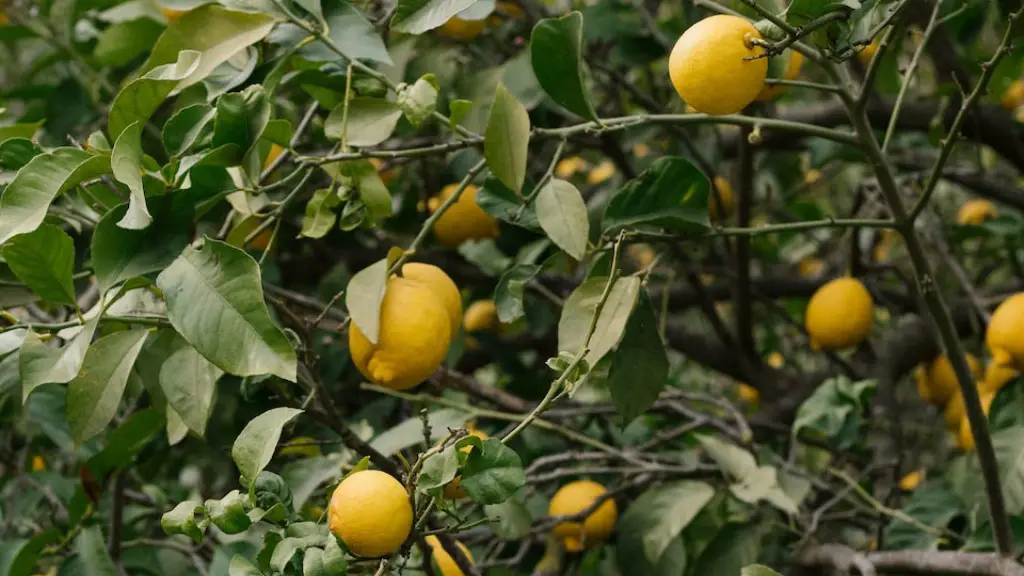During the winter season, protecting a lemon tree from cold temperatures and frost damage is very important for achieving optimal yields. Fortunately, there are several methods that one can employ for this purpose.
To start, it’s important to note that lemon trees can be very sensitive to cold temperatures and frost damage, so extra care should be taken to protect them during the winter months. One of the most effective ways to protect a lemon tree is by providing it with shelter, such as by using fabric shielding or a greenhouse to keep temperatures high and minimize frost damage. Additionally, some gardeners find it helpful to provide the tree with a thick layer of mulch to insulate the soil, which helps to keep temperatures around the tree elevated.
Another important element in protecting lemon trees during the winter season is to give them enough water. It’s important not to overwater the tree, as too much moisture can actually damage the tree’s roots; however, enough hydration is necessary so that the roots do not become too dry. In some cases, adding a cover over the soil may also be a good idea to protect from too much moisture, but this should be done carefully to ensure that the tree still receives enough air.
In addition to providing shelter and water, it’s also important to prune the lemon tree before winter hits in order to promote healthy growth and minimize any future damage from wintery conditions. During pruning, it’s best to cut away any dead or diseased branches, as this will help to promote healthy growth during the winter months. Additionally, it may also be wise to fertilize the tree several weeks before the onset of winter, as this will provide the tree with extra nutrients to help it stay strong during the winter season.
Finally, it can be beneficial to use a good quality indoor plant heater to keep temperatures around the lemon tree at a constant level, as this will help to protect it from frost damage even during periods of unexpected cold snaps. Additionally, if possible, bringing the tree indoors during particularly cold nights may also be wise in order to protect it from the coldest temperatures.
Providing a Protective Cover
Another important element of protecting a lemon tree in winter is to provide it with a protective cover. This can be done in a variety of ways, but in general, it is best to use some sort of shelter that can block the wind and help keep temperatures around the tree more consistent. This could include using fabric shielding such as burlap, or building a simple greenhouse over the lemon tree. Shading the tree during the day is also important, as this will help to keep temperatures around the tree at a reasonable level.
Protecting the Roots
Another key factor in protecting a lemon tree in winter is to ensure adequate protection for the tree’s roots. This can be done in a number of ways including adding a thick layer of mulch around the tree’s base, which will insulate the soil and keep temperatures from dropping too low. Additionally, it may also be a good idea to cover the ground around the tree with a tarp or plastic sheeting in order to protect it from the elements. However, this should be done carefully, as too much coverage can block air circulation and deprive the tree of necessary oxygen.
Lemon Trees and Frost Damage
Since lemon trees are particularly susceptible to frost damage, it is important to take precautions in order to protect them during winter. This could include taking steps to ensure that the tree is sufficiently hydrated, as well as providing extra shelter and insulation. In addition, pruning away any dead or diseased branches and fertilizing the tree several weeks before winter can also help to promote healthy growth. Additionally, using an indoor plant heater can help to keep temperatures around the tree at a constant level and further protect it from frost damage.
Taking Steps Before Winter
Before the winter season arises, some steps should be taken to ensure that a lemon tree is properly prepared for the cold months. This could include pruning the tree, fertilizing it, and providing additional shelter and insulation. Additionally, it is a good idea to make sure that the lemon tree’s roots are adequately hydrated and covered, so as to minimize any potential damage from frost. Taking these initiatives prior to winter hitting can also help to promote healthy growth during the winter season.
Protecting the Tree in Winter
Once winter has arrived, there are still some precautionary measures that can be taken in order to protect a lemon tree from frost damage. These could include providing the tree with a good quality indoor plant heater to keep temperatures at a constant level, as well as bringing the tree indoors during particularly cold nights. Additionally, it can also be beneficial to provide the tree with a thick layer of mulch, as well as a cover over the soil, in order to protect it from the cold temperatures.
Conclusion
Protecting a lemon tree in winter is essential for promoting healthy growth and achieving optimal yields. Taking the proper steps, such as providing the tree with shelter, hydration, and insulation, can greatly minimize damage caused by cold temperatures and frost. Additionally, taking preventive measures, such as pruning and fertilizing, before the coldest weather arrives can also help to promote healthier growth during winter.


